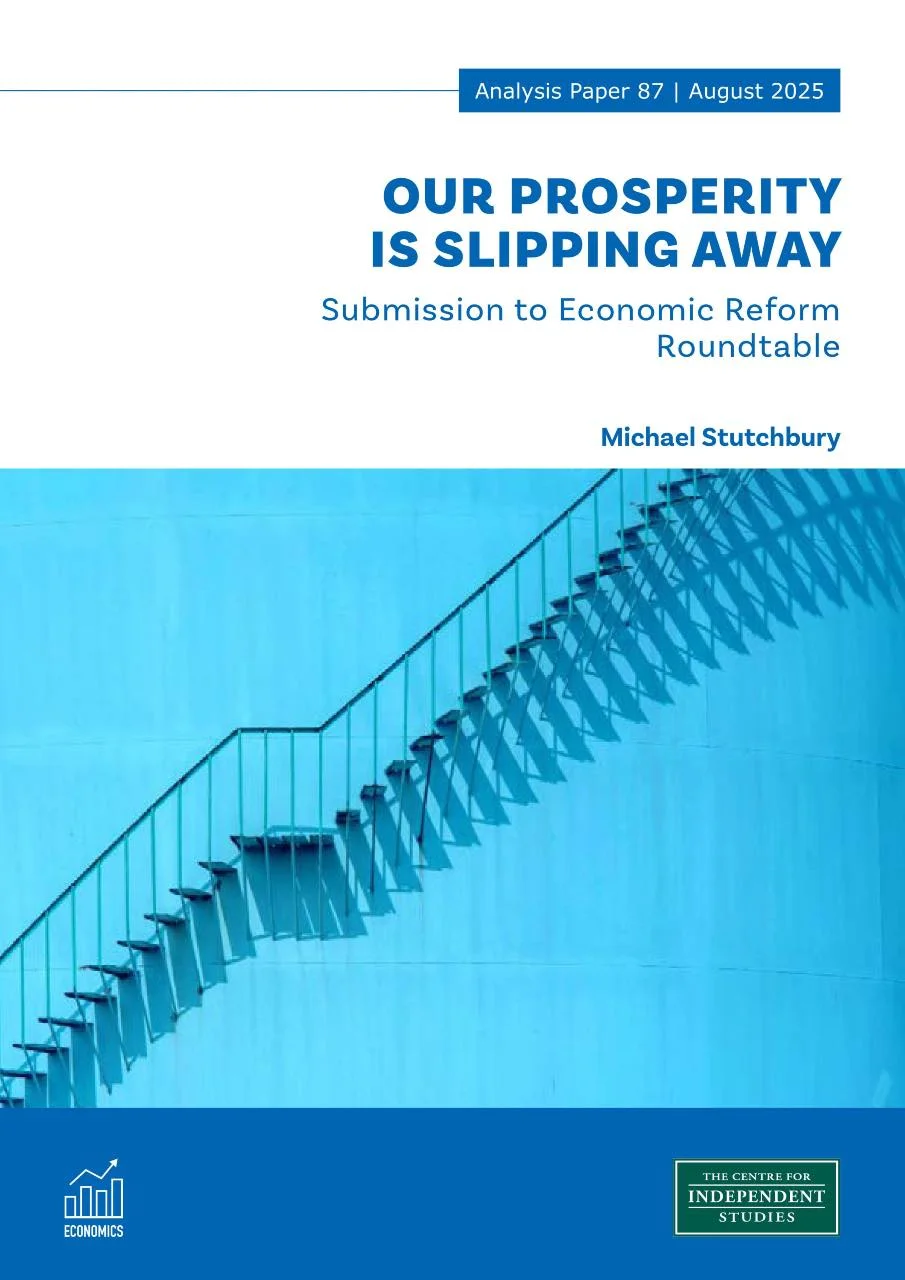
Introduction
As Reserve Bank deputy governor Andrew Hauser noted last year, it can be easy to forget just how prosperous modern Australia became in the first decade or two of the 21st Century. Measures of relative affluence, such as GDP or wealth per head, regularly now place Australia “in the top echelon” globally, as Hauser noted. Australia’s per capita income remains significantly higher than in the UK, Germany, Sweden or Japan, for instance. This has been of enormous benefit to nearly all Australians.[1]
But Australia has experienced comparable periods of relative affluence before in its history — such as in the 1850s to the 1880s, in the early 1950s and the late 1960s to early 1970s. Such periods have generally given way to lengthy periods of relative under-performance. This has much to do with Australia’s economic structure as a commodity-exporting and capital-importing developed nation.
In this instance, our relative modern prosperity has been built first on the foundation of the economic liberalisation of the 1980s and 1990s, laid by the supply-side deregulation of financial, product and, to an extent, labour markets. This resort to open and competitive markets gained bipartisan political support around promoting aspiration, opportunity and prosperity. This pro-market reform era, in turn, allowed Australia to exploit elevated Chinese demand for our resource exports such as iron ore, coal and gas in the 2000s.
Hauser’s “easy to forget”[2] reference is another way of describing the national complacency about Australia’s modern prosperity. Public debate — including from political leaders — shows little appreciation about the nature of the nation’s recent exceptionalism and the source of national prosperity over the past few decades.
More worrying is that this modern prosperity most likely peaked after the Global Financial Crisis in 2011 and 2012 along with the peaking of the iron ore price at $US180 a tonne. It has been slipping away for more than a decade.
Reining in the post-pandemic inflation outbreak while keeping the unemployment rate below 5% has been a genuine policy achievement. But labour productivity remains at 2016 levels. Average household incomes remain below pre-pandemic levels in real terms.
The federal budget is projected to be in deficit for a decade as public debt rises through the trillion dollar mark.
The economy’s terms of trade (or ratio of export prices to import prices) is likely to continue to trend down from the temporary record highs recorded during the pandemic, amounting to a loss of national income.
Business investment in growing future prosperity remains at a level not much higher than just after the early 1990s recession, limiting the scope for productivity growth and higher wages.
The RBA’s paring back of its assumption for the economy’s labour productivity growth to just 0.7% annually translates into a lowering of Australia’s economic growth potential — or its supply-side capacity — to just 2%. This represents a sharp fall from the 3% to 4% economic growth posted in the 1990s and into the 2000s. It represents an unambitious and unacceptable low growth economic outlook.
The Economic Reform Roundtable should commit to making Australia an aspirational and enterprise-driven high growth nation bursting with investment opportunities.
More broadly, the intergenerational social contract has been put under strain by the sharp rise of housing prices because of policy-induced restrictions on the supply of housing.
The “thickets of red tape”[3] that are now recognised to have prevented housing supply from responding to housing demand are replicated through much of the economy, including on an excess compliance burden on business.
Notwithstanding substantial increases in taxpayer funding, Australian school student performance — foundationally critical to the nation’s stock of human capital — has fallen both in absolute terms and in relation to international peers.
Australia’s traditional competitive advantage of low cost energy has been turned into a disadvantage amid a clean energy transition that has proven more costly than projected, in turn undermining hopes of a ‘Future Made in Australia’.
The labour market is being re-regulated in ways not suited to the demands of an open economy, accelerating technological change and a more diverse society.
Amid all this, rising geo-political tensions are dismantling the rules-based global trade and security order — including the WTO system and the US alliance — on which Australia’s modern prosperity rests.
Given these headwinds, the reality confronting the Economic Reform Roundtable exercise is that it will take either the highest-quality policy settings across the board or an unexpected sharp improvement in fortune to prevent a further slippage of Australia’s relative affluence.
The political economy problem is that, at the peak of this prosperity, national discourse has focused on redistributing it, rather than producing more of it. This shows up most clearly in the worsening fiscal position, at both federal and state levels.
The fiscal problem has been caused largely by inflated spending demands baked into Australia’s political system during the period of rising national prosperity. This then coincided with popular new theories (such as ‘the deficit myth’ and ‘modern monetary theory’) and even central bank innovations (such as quantitative easing) that weakened notions of a traditional budget constraint.
This dynamic was further fuelled during the pandemic, when the potentially disastrous downside risks provoked the unprecedented peacetime levels of government spending — and cheap money — that spilled over into the inflation outbreak. Yet even the inflation episode has not quelled political aspiration for more ‘universal’ care economy programs, such as for subsidised childcare, that encourage a growing culture of dependency.
Preserving Australia’s modern prosperity must recognise that public spending needs to be reined back to within the nation’s less bountiful means. ‘Tax reform’ should not become an exercise in increasing the level of taxation so as to validate the increased share of the economy taken up by mostly low-productivity government spending. The opposite needs to happen. The ratcheting up of government spending needs to be reversed to facilitate genuine productivity-enhancing tax reform and to make room for more productive private sector growth, including business investment in new productive capacity.
Begin by reining in excess government spending
The RBA’s Hauser nominates “strong but adaptable pro-growth institutions”[4] as one of the important drivers behind Australia’s relative affluence. Yet a weakening of fiscal institutions has facilitated an increase in total government expenditure from 34 to 35% before the global financial crisis to a new plateau of above 38% following the pandemic. At the Commonwealth government level, government expenditure has increased from 24 to 25% to above 27%. It is concerning how key submissions to the Roundtable downplay this as an issue to be confronted.
Since 2012-13, Commonwealth budget expenses have grown in real per capita terms by 1.8% a year on average compared with labour productivity growth of 0.5% and per capita GDP growth of 0.8%, CIS research has highlighted.
Expenditure growth has been driven particularly by the National Disability Insurance Scheme, which continues to expand wildly beyond its original forecasts and scope, along with school and public hospital funding, the Pharmaceutical Benefits Scheme, childcare subsidies, defence, transport infrastructure, the horizontal fiscal equalization guarantee, public debt interest and cost-of-living subsidies such as for fuel and power bills. Even as the excess public demand-induced inflation recedes, it will mean persistent budget deficits, rising public debt and taxation, weak productivity growth and societal consequences of deepening dependency on government.
Reimpose credible fiscal rules to get government under control
Reversing the ratcheting up in government spending as a share of the economy will require the reinstatement of genuine fiscal rules, or guard rails to help prevent the budget from drifting or lurching into excesses of deficit financing, debt, expenditure and taxation. Such rules are required to re-anchor and discipline expectations akin to the Reserve Bank’s 2 to 3% inflation target for monetary policy.
As Ken Henry has complained, “every Australian government since the Rudd government” has failed to meet its obligations under the 1998 Charter of Budget Honesty. Even after the global financial crisis, budget papers continued to commit to a fiscal rule of running a balance, or even a surplus, over the course of the economic cycle. This pretence was jettisoned during the crisis of the pandemic. Now there is not even any formal commitment to returning the budget to balance or surplus.[5]
An explicit fiscal rule now should be to return the budget to at least structural balance within a few years. This would require a fiscal consolidation no greater than delivered by the Hawke-Keating and Howard-Costello governments in the 1980s and ‘90s.
Such a rule would include keeping government spending growth within the growth of the economy, along with a cap on taxation as a share of the economy. As a maturing program, the NDIS should grow by less than the new lower targeted annual nominal rate of 8 per cent. The budget balance rule should extend to a target for stabilising and reducing government debt as a percentage of GDP to account for the increasing resort to off-budget spending.
Tax reform must not validate bigger government
The aggregate levels of both state and Commonwealth taxation are at or near historic peaks relative to GDP. Fiscal deficits reflect high levels of expenditure rather than low levels of revenue. Marginal personal income tax rates imposed on middle and high income earners are excessive and the top rate income threshold is far too low.
While there are often calls to make the tax system ‘fairer’ by shifting more of the load to higher income earners, and particular taxes are marked as ‘regressive’, analysis of the overall tax system reveals that it is already highly progressive and substantially reduces inequality. A glaring problem, however, is that the burden of personal income tax is projected to grow to record highs through bracket creep. The federal budget’s projections for returning to balance by the mid-2030s are based on exploiting bracket creep to help finance the increase in less-productive government spending. That threatens to worsen the burden on younger working Australians who will be required to support a proportionately larger share of older generations.
Tax reform can foster productivity growth by improving allocative efficiency and incentives for innovation, business investment and investment in human capital. However, it will weigh more heavily on productivity if it seeks to increase overall taxation and its progressivity.
Index the personal tax scales
A priority for structural reform of the tax system should be to introduce automatic annual indexation of the personal income tax thresholds. By eliminating the dishonest stealth tax of bracket creep, this would introduce needed discipline on the budget process. The revenue cost would be small initially and would grow over time. This would reinforce the case for fiscal rules, as proposed above, to strengthen expenditure restraint.
Along with an over-reliance on income tax, Australia’s 47% top marginal tax rate (including the Medicare levy) is high by international standards and cuts in at a relatively low income threshold. Paul Keating suggests that the top marginal rate should be no higher than 40%.
The next reform priority should be to lift the threshold for the top marginal rate to at least $250,000, which would account for inflationary bracket creep since the last major increase in the threshold more than 15 years ago. The increase from $180,000 to $190,000 in 2024 under the rejigged ‘stage three’ tax cuts was a token change.
Then the 37% rate should be removed as originally proposed by the Coalition’s original stage three tax cuts to ensure that the great bulk of taxpayers are on a marginal rate no higher than 30%.
Cut the 30% company tax rate for all businesses.
Sustained economic growth based on productivity growth depends on resuscitating business investment. A key to this is reducing the tax burden on companies. Foreign investment into Australia is strongly influenced by differences in rates of return on capital across borders.
The Productivity Commission’s interim report Creating a more dynamic and resilient economy clearly sets out how Australia’s 30% company tax rate has moved from being well below the international average to significantly above it over the past four decades. Australia needs to cut company tax to 25% to boost business investment.
The short-term costs of lower company tax should be seen as a government investment, just like investment in infrastructure or improved education. Many international studies show that lower company taxes boost GDP, employment, productivity and real wages. Australian evidence shows that domestic companies respond positively to a lower tax rate, meaning tax cuts work and are not neutralized by our imputation system. Importantly, most of the benefits of corporate tax reductions go to workers, not to big business nor foreigners. Modelling estimates the substantial benefits of cutting company tax, but the modelling may underestimate the benefits.
Tax avoidance does not argue against a lower company tax rate. Failing to cut company tax would make tax avoidance worse, penalise those companies that engage in the least tax avoidance, and leave the largest tax avoiders unaffected.
Saving should be taxed less
The case for reforming the taxation of saving is that there are wide disparities across the various forms of saving. Greater uniformity should be the aim. Any review of taxation of saving, however, should not be premised on the search for greater revenue, as there is a sound economic case for modest rates of tax on income from saving, including for capital gains and superannuation.
Rather than ad hoc policy proposals — such as the government’s proposed tax on income from superannuation balances above $3 million — changes to the taxation of saving should be part of an overall package of reforms guided by a clear set of tax reform principles.
Spending needs to be controlled to facilitate pro-growth tax reform
To repeat, tax reform should not become an exercise in increased taxes to validate the increase in low-productivity government spending.
The last substantial tax reform package — the GST and personal income tax reductions of 2000 — came amid a much stronger fiscal position that allowed compensation for losers. So substantial tax reform will likely first require an improvement in the fiscal position. Inconveniently, policy slippage in one area can reduce the degrees of freedom for policy changes in other areas.
The constraints imposed by an unsustainable budget position are highlighted by the Productivity Commission’s Creating a more dynamic and resilient economy report. The apparent requirement that changes to company tax be budget neutral has resulted in the PC perversely recommending a new 5% net cash flow which would amount to an increase in the company tax rate to 35% cash for 500 of the biggest companies with annual revenues over $1 billion. Amid the possible merits of a net cash flow tax, this would increase the complexity of entrenching different tax rates on companies according to their size.[6] [7]
Focus on supply-side regulation and compliance
Work by CIS has shifted the debate to accepting that restrictions on housing supply are the driving cause of housing shortages and higher prices that have resulted in prohibitive housing costs, as discussed below. This has become a bipartisan political position. But the “thickets of red tape”[8] restricting housing supply are simply the most obvious example of Australia’s wider anachronistic and inconsistent landscape of excess regulation.
Supply-side restrictions also frustrate the rollout of renewable energy projects, hampering Australia’s capacity to reduce carbon emissions. Removing these thickets to liberate enterprise, reward and productivity will be a renewed focus of CIS.
Research and stakeholder consultation has pointed to three common themes in regulatory burdens across the economy: planning and zoning creep, environmental regulation and regulatory inconsistency. The requirement for regulatory impact statements accompanying new legislation has become ineffective, similar to how fiscal rules have fallen away. The unchecked regulatory burden accumulates in rising business compliance that undermines flexibility, increases costs and blunts economic dynamism.
This is now being increasingly recognised in comparable economies, including following the regulatory response to the global financial crisis. In the UK, Labour prime minister Keir Starmer has vowed to cut compliance costs on British business by 25% by the end of his current term.
This raises the issue that the costs of regulation are inadequately measured (or not measured at all), evaluation of regulatory outcomes are piecemeal and that the costs of imposing layer upon layer of competition are poorly understood. In Australia, financial institutions such as the Macquarie Group have measured their annual direct compliance costs as exceeding $1 billion.
CIS supports the thrust of the Productivity Commission’s Creating a more dynamic and resilient economy interim report that calls for “a whole-of-government statement to commit to regulation outcomes that better promote growth and dynamism”.
In a new CIS paper, Addressing Australia’s Productivity Problem,[9] economist Jim Cox sets out a blueprint for the Charter of Regulatory Effectiveness (CORE) — a proposed legislative instrument for Commonwealth, state and territory governments. This CORE would be based on four principles.
First, under regulatory stewardship, each independent regulator and public-service chief executive would be legally obliged to keep their legislative instruments up-to-date, scrub obsolete rules, and advise ministers on productivity-blocking provisions.
Second, under codified principles, parliament would embed a statutory checklist requiring regulators to prioritise innovation and economic dynamism, adopt risk-based and proportionate responses and deliver transparent and timely decisions.
Third, as part of public accountability, a central minister would be required to table a periodic report to parliament measuring the productivity impact of every regulatory system.
And, with ex-post reviews, system-wide audits would replace one-off regulation hunts, ensuring rules keep pace with technological change and business realities.
In this spirit, CIS is encouraged by Treasurer Chalmers’ move to seek “specific, measurable actions” from regulators across government to “reduce compliance costs without compromising standards”.[10] [11]
Boost housing supply
A relaxation of planning restrictions differs from many other policies being considered at the Roundtable in that it is supported by a large and robust evidence base, including from CIS and the NSW Productivity Commission.
The strong academic consensus in favour of relaxing zoning restrictions to allow more housing supply, particularly more medium-density housing supply, has flowed through to government policy at a federal and state level. Yet media is still filled with proposals that research shows will do little to improve housing affordability.
In particular, proposals to restrict negative gearing and the capital gains discount have been estimated by several respected economists, using different approaches, to reduce housing prices by only 1 to 4% while increasing rents. Similarly, mandating affordable housing within development proposals acts as a tax on development and reduces overall supply. Studies find they do more harm than good.
The value of a Sydney apartment, as of 2021/22, was $1 million. However, it could be supplied for $600,000 if planning rules allowed, according to calculations by CIS chief economist Peter Tulip.[12] Planning restrictions limit supply, push up prices and rents, driving a large wedge between the cost and benefit of new homes. So a shift of resources into housing would directly boost national productivity.
Doubling urban density is estimated to increase business productivity and wages by 4 to 13%. Ideas circulate more freely and workers learn more from each other when they are in close proximity. Firms benefit from economies of scale. In contrast, high housing costs drive workers away from locations where they are most productive. Studies in the US have found that relaxing zoning restrictions would boost US GDP by 8%.
Planning restrictions are sometimes justified as improving neighbourhood amenity. However, nearby house values are little affected by large increases in density. As judged by willingness to pay, neighbourhood character is not harmed by new apartment buildings. For every resident who dislikes the look of the new buildings or the increased congestion, others prefer a lively walkable neighbourhood, with the shops, entertainment options and better transport that accompany greater density.
What should the federal government do?
National Cabinet’s target of 1.2 million homes strikes a sensible balance between ambition and feasibility. However, it will not be achieved without serious support measures. While state and local governments have main responsibility for land use regulations, there is much the federal government can and should do to encourage better housing policy.
Infrastructure bottlenecks hinder housing supply by delaying the delivery of essential services such as roads, water, sewerage, electricity and public transport to new housing developments. Without these services in place, land that is zoned for housing cannot be developed efficiently, slowing the release of new homes to market.
These bottlenecks also increase development costs, as buildings and developers may face additional expenses to connect new projects to existing networks. Furthermore, inadequate infrastructure reduces the capacity of certain areas to accommodate population growth, leading to mismatch between housing demand and supply. This restricted supply contributes to higher housing prices and worsens affordability issues.
Federal government grants for specific projects can help overcome the infrastructure bottlenecks, accompanied by agreements with local and state governments for new housing. In particular, federal grants for rail investment should be dependent on high density residential development at train stations. Untied federal grants can also improve incentives in a revenue-neutral manner, through early payment of the New Homes Bonus or by making Commonwealth Grants Commission distribution of GST money to the states dependent on housing completions.[13]
State taxation and housing
Although the Commonwealth raises about 80 per cent of all tax revenue in Australia, some of the most distorting and inefficient taxes are levied by the states. Prominent among these are stamp duties on property transfers and insurance.
Over the long term, states have benefited from huge growth in stamp duty revenue from property, as increases in values interacted with progressive stamp duty scales to produce massive bracket creep. In general, state governments have not lifted thresholds to reflect increased values, resulting in transactions drifting into higher duty brackets.
The huge increase in the weight of stamp duty on real estate transactions over time places a burden on buyers and sellers of homes. It is widely recognised as one of the most distorting taxes. At the margin, it locks people into inappropriate housing and discourages mobility, including for people to take up job opportunities. For these reasons, various government-initiated tax reviews have recommended replacing stamp duty with broader and less distorting taxes, including land tax.
Initiatives such as tax switch should be explored but would need to be implemented carefully to as not to lift the overall tax burden over time. In an ill-designed and implemented switch, the ACT government embarked on a 20-year phase-out of stamp duty to be offset by higher land tax rates. But after many years, a substantial stamp duty load remains on most transactions, even though land tax rates have risen substantially.[14]
Reverse the decline in school performance
Australia’s long-term productivity performance is constrained by weakening human capital formation over recent decades, primarily due to poor results from the school education system.
Around one in three students do not meet literacy and numeracy proficiency standards in NAPLAN. Only one in two disadvantaged students achieve proficiency. And students’ PISA results have declined more steeply and consistently than almost any other country over the past two decades.
Foundational skills are among the strongest predictors of an individual’s long-term living standards and productivity. However, Australian Industry Group data indicates that 88% of employers report that workers’ low literacy and numeracy skills directly erodes their productivity. Across advanced economies, the OECD attributes about one-sixth of the slowdown in multifactor productivity growth over recent decades to declining human capital quality.
OECD modelling implies that Australia’s 37-point decline in mathematics since 2003 can be associated with a 5.2% fall in GDP per capita. At current levels, that equates to more than $135 billion in lost national income every year.
Reversing Australia’s student achievement decline in PISA scores would lead to an estimated 5.5% increase in annual earnings for each school-leaving student. For a typical graduate entering the workforce, this translates to around $3,300 more income per year, over $130,000 in additional lifetime earnings, and around $35 billion in earnings gains each year (based on a year 12 graduating cohort of around 260,000 students).
If Australian students achieved at the level of counterparts in the world’s top-performing school systems — such as Singapore — it would likely result in up to a 13% boost in their annual earnings over their working life. For the average student, this equates to more than $9,000 in additional income per year, and over $370,000 in total additional earnings over their lifetime.
Australia’s school sector has also become less productive in its own right — with the education system absorbing more resources for less impact. ABS analysis indicates that multifactor productivity in school education fell by 1.2% per year from 2008-09 to 2018-19. A reasonable estimate is that from 2000 until now, there has been around one-quarter less learning output per unit of input into the school system. Most of this results from significant declines to student–staff ratios – that is smaller class sizes.
School education policy must focus on effectiveness, not just the level of investment. Reforms must better result in more effective teaching practice in classrooms. It is estimated that consistently lifting the quality of classroom teaching practices could result in at least one year — and up to two years — worth of student learning gains over the course of schooling.
Importantly, much of education policy over recent decades has focused more on resource distribution than on lifting the return on the investment. International research by education economist, Eric Hanushek shows that the greatest economic returns in education come from improving average student achievement — particularly in foundational skills like literacy and numeracy — compared with other policy goals, such as increasing school attainment alone or redistributing resources in narrowing inequality alone.
While equity measures remain important, the most effective strategy — economically and educationally — is to ensure that all students are learning more each year through higher-quality teaching and curriculum resources.
Tie funding to better education results
First, the additional funding that has been agreed to in the Better and Fairer Schools Agreement must be tied to measurable results and accountability. The agreement introduces new national and state targets for student achievement for the first time — with ministers committing to lift the percentage of students who are proficient in literacy and numeracy in NAPLAN and halving the gap for disadvantaged groups by 2031.
But these must become more than aspirational statements and have accountability to match. Performance must be tracked transparently, publicly reported, and directly linked to further funding decisions. There must be some sense of what will happen if states and territories do not lift their game.
More to do on teacher training
Second, the government must finish the job on teacher training and teaching practice. Education Minister Jason Clare did well in his first term to initiate new standards for university teacher trainers through the Strong Beginnings review and report on initial teacher education.
This has meant additional practical experience during training as well as reforms that, in theory, require new teachers learn about effective teaching practices and the science of learning that underpins great teaching — with non-compliant providers effectively disqualified.
But there is currently little to no confidence that the desperately needed quality assurance will actually take effect. The hard part is not just defining new standards but enforcing them. If it’s anything like the similar reform effort in the UK, it will require being tough and placing unforgiving penalties on universities that don’t lift their game.
Rewrite teacher standards
Third, reforms of the Australian Professional Standards for Teachers must sit alongside Initial Teacher Education reform.
The current standards do not adequately reflect the vision of ‘good teaching’ that has been defined by the Strong Beginnings report, and nor do the professional standards articulate the specific knowledge and practices required to be an effective teacher. This stands in stark contrast to other professions such as law, medicine or accounting. England’s Early Career Framework can be a valuable guidepost for successful policy in this area.
World-competitive curriculum
Fourth, Australia cannot lift its educational outcomes to a world-competitive level without a world-competitive curriculum.
The Australian Curriculum suffers from ‘curriculum by committee’ syndrome that means its content is closer to lowest-common-denominator than a high minimum standard for all Australian students. The curriculum is due for review starting in the following year. This next review should go beyond tinkering and ensure it represents a knowledge-rich, coherent, sequential and cumulative approach in line with international best practice.
Bring education into productivity agenda
Finally, this roundtable process and the subsequent government response must make education central to the wider productivity agenda.
Education is too often treated as a social policy issue: important, but separate from the engines of economic growth. But that’s a mistake, as Australia’s long-term productivity challenge cannot be solved without serious improvements in school performance.[15] [16] [17] [18]
Restore Australia’s low-cost energy advantage.
Australia’s post-World War Two industrialisation was built on cheap coal-fired electricity generation. The low-cost energy advantage underwrote the investment in energy-intensive refining and smelting operations.
Australia is said to have a comparative advantage in generating electricity from solar and wind power. Yet, as Australia has increased the penetration of such renewable energy, the price of electricity has risen — as it has with every country that adopts a grid with high levels of wind and solar. The inherent unreliability of weather dependent wind and solar means that the electricity system must be built larger than required and used at sub-optimal rates.
According to OECD data, from 1978 to 2018, Australia moved from having the 7th cheapest power in the OECD group of 36 countries, to the 28th place.
Yet CIS analysis has calculated the existing federal subsidies to wind and solar energy projects up to 2023 amount to $29 billion, even without accounting for state-level subsidies. There are now almost no wind or solar projects going ahead without government subsidies, with the cost of the Capacity Investment Scheme still undisclosed. The push to reach 82% renewable energy by 2030 threatens to dwarf previous costs.
In calling for an economy-wide carbon price, Ross Garnaut has warned that the current reliance on the Capacity Investment Scheme will leave Australia well short of hitting its 82% target, while imposing unacceptable budget costs.[19]
Combating global warming is a worthy goal. But Australia’s current efforts to reduce carbon emissions have undermined the economy’s traditional low-cost energy advantage.
Along with budget handouts to obscure the rise in electricity costs from households, the fallout is now leading state and federal governments to use more taxpayer money to prop up uncompetitive aging lead smelters that will likely extend to aluminium. This is literally a ‘Past Made in Australia’ policy: another example of sub-optimal policy leading to more bad policy.
The collection of energy system regulators and climate policy advisers are driven by clear instructions to reduce carbon emissions to “net zero” by 2050 while retaining the reliability of supply.
But seemingly no regulators or advisers are charged with ensuring that Australia will regain its cheap energy advantage during the clean energy transition. Making some regulator or adviser responsible for lower priced energy is required for basic transparency, let alone doing something about it.
Endnotes
[1] Andrew Hauser, Strangers in Paradise, Speech at Citi A50 Australian Economic Forum. 27 June 2024.
[2] ibid.
[3] Jim Cox. Addressing Australia’s Productivity Problem. CORE Blueprint to Unshackle Productivity. August 14, 2025. https://www.cis.org.au/publication/addressing-australias-productivity-problem-core-blueprint-to-unshackle-productivity/
[4] Andrew Hauser, Strangers in Paradise, Speech at Citi A50 Australian Economic Forum. 27 June 2024.
[5] Ken Henry, Address to Per Capita Tax Summit, 20 February, 2025
[6] Michael Potter (2016) Fix it or Fail: Why we must cut company tax now, CIS Research Paper 20 https://www.cis.org.au/publication/fix-it-or-fail-why-we-must-cut-company-tax-now/
[7] Jeff Bennett, Michael Potter, Tony Makin (2020) Lower Company Tax to Resuscitate the Economy, CIS Policy Paper 31 https://www.cis.org.au/publication/lower-company-tax-to-resuscitate-the-economy/
[8] Jim Cox. Addressing Australia’s Productivity Problem. CORE Blueprint to Unshackle Productivity. August 14, 2025. https://www.cis.org.au/publication/addressing-australias-productivity-problem-core-blueprint-to-unshackle-productivity/
[9] ibid
[10] National Press Club address 18 July 2025
[11] Gene Tunny, Ben Scott. Rationalising Regulation: Helping the economy recover from the corona crisis. September 23, 2020 · AP14 https://www.cis.org.au/publication/rationalising-regulation-helping-the-economy-recover-from-the-corona-crisis/
[12] Peter Tulip. Housing Affordability and Supply Restrictions · February 8, 2024 · PP55. https://www.cis.org.au/publication/housing-affordability-and-supply-restrictions/
[13] Grahame Campbell. Bungles, Blowouts and Boondoggles: why Australia’s infrastructure projects cost more than they should. November 23, 2023 · OP198 https://www.cis.org.au/publication/bungles-blowouts-and-boondoggles-why-australias-infrastructure-projects-cost-more-than-they-should/
[14] Robert Carling. Stamp duty needs reform. November 19, 2013 https://www.cis.org.au/commentary/opinion/stamp-duty-needs-reform/
[15] Glenn Fahey , Rob Joseph. Starting off on the wrong foot: How to improve Initial Teacher Education in Australia. August 14, 2023 · AP53 https://www.cis.org.au/publication/starting-off-on-the-wrong-foot-how-to-improve-initial-teacher-education-in-australia/
[16] Trisha Jha. What is the Science of Learning? February 15, 2024 · AP63 https://www.cis.org.au/publication/what-is-the-science-of-learning/
[17] Rebecca Birch. Reimagining Teacher Professionalism. Why standards must be part of ITE reform. March 21, 2024 · AP64 https://www.cis.org.au/publication/reimagining-teacher-professionalism-why-standards-must-be-part-of-ite-reform/
[18] Submission into Productivity Commission’s Review of the National School Reform Agreements June 2022 Centre for Independent Studies https://www.pc.gov.au/__data/assets/pdf_file/0007/342691/sub043-school-agreement.pdf
[19] Ross Garnaut Address to Clean Energy Summit, 29 July 2025.









